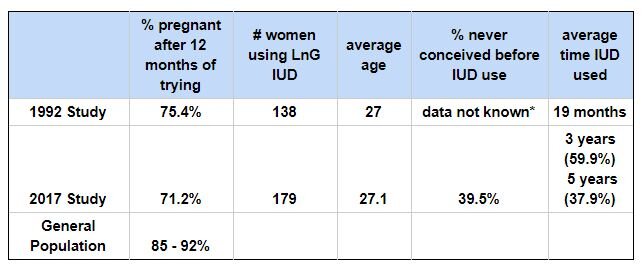Fertility & Levonorgestrel IUDs
Female scientists reveal how much we still don’t know about intrauterine devices and fertility.
Touted as the “set it and forget it” contraceptive option, intrauterine devices (IUDs) are expected to provide an immediate and complete return to fertility. Challenging this expectation, three female scientists collaborated on a paper that points out how little is actually known about the long-term effects of levonorgestrel (LnG) IUDs on fertility.
The FDA has approved four LnG IUDs (see table below). These IUDs will send out low-levels of progesterone, which thickens the uterine lining in the cervix and impedes sperm from easily swimming through. The LNG-IUDs can impact ovulation soon after insertion, but this impact has been found to go away within a year.
Regarding fertility, the LNG IUD’s impact is purportedly reversible - but how reversible is it? Does the reversibility depend on whether or not a women had a child before using the IUD?
Below is key information from the two largest studies looking at Lng IUD use and pregnancy outcomes.
Observations:
Neither study separated the pregnancy results for women who had already conceived from women who had never conceived—->harder to tease out the results based on either woman
Neither study separated out the pregnancy results for the women who had used the IUD for short periods of time (< 2-3 years) vs. long periods of time (3-5 years)
So, we still don’t know if or how LnG IUDs impacts the fertility of women who have never had children. We also don’t know how the LnG IUD impacts the fertility women who used the IUD for closer to five years.
Per clinicaltrials.gov, there are no approved trials coming up to answer either of these key questions.
CONCLUSIONS
It’s possible that the IUD has a lasting impact on the endometrium even after being removed, which may impact fertility. It’s also possible that the IUD impacts the fertility differently for women who have already conceived vs. women who have never conceived. We don’t know…sigh.
To decrease the uncertainty of LnG IUD impacting fertility, our ideal study would:
Test thousands of IUD users to get as much information as possible
Track how long each woman uses the IUD
Track live births (since this is what we ultimately hope comes from pregnancy)
Distinguish and note if there are differences in fertility between women who have and who have not had a baby before using the IUD
Additional Resources
Dinehart, E., Lathi, R.B. & Aghajanova, L. Levonorgestrel IUD: is there a long-lasting effect on return to fertility?. J Assist Reprod Genet 37, 45–52 (2020). https://doi.org/10.1007/s10815-019-01624-5
Andersson K, Batar I, Rybo G. Return to fertility after removal of a
levonorgestrel-releasing intrauterine device and Nova-T. Contraception. 1992;46(6):575–84. https://doi.org/10.1016/0010-7824(92)90122-A
ClinicalTrials.gov [Internet]. Bethesda (MD): National Library of Medicine (US). [cited 2020 Mar 2]. Available from: https://clinicaltrials.gov/ct2/results?cond=&term=levonorgestrel%2C+intrauterine&cntry=&state=&city=&dist
Creator of IUD Diagram: MIT OpenCourseWare. For more information, view http://ocw.mit.edu. No changes made to diagram. Found on Flickr.







